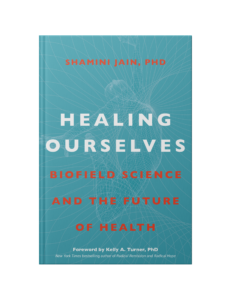Express Your Creativity to Jump-Start Vitality
Have you ever felt like you lost a part of yourself?
Sometimes it happens. Life changes, and we change with it. It could be a move, job change, marriage, kids, taking care of elders, or any sort of transition. Sometimes it’s not even a difficult transition that makes us lose a part of ourselves but a decision we make to keep on with some things and release the rest. And yet, we might regret leaving that part of us behind. Often, the part of ourselves we leave behind is a creative part of ourselves that we might think, in today’s world, is less important or less valued.
This certainly happened to me—for about fifteen years. Basically, I lost my voice. As much as I loved singing, for reasons I could not fully understand, I knew part of my path was to continue in my study of healing. Unfortunately, when I chose graduate school, I also decided there was no point in singing anymore if I was not “serious.” Not only did I relinquish my opportunity to prepare for a professional career in classical western opera singing—I simply stopped singing altogether. And by making that black-and-white decision, based more in perfectionism than in feeding my heart and soul, I lost a huge part of myself for more than fifteen years. Singing was a gift I was given to bring me back to my own creative bliss—but I had been blind to its purpose for most of my life. And a part of me literally felt like I had died.
I’ll bet many of you can relate. External circumstances seem to shift the tides of our lives so that sometimes we lose parts of ourselves society doesn’t necessarily directly reward. If we enjoyed art, dance, music, or other areas of creative expression when we were young, unless we pursued these passions as professional artists, we might have lost sight of them over the years. We often think we have to leave creative pursuits behind in our process of “adulting”—making money, providing for a family, and pursuing a career. However, losing that creative juice comes with real costs—we can end up losing our ability to innovate, our fluidity, and a great deal of our joy.
Thankfully, our creativity is never really lost. In my case, I found the joy of singing again spontaneously while singing to my kids when they were young. When they got a bit older, I decided to reclaim the fun of singing for myself. Out of the blue, I created a Guns N’ Roses cover band called Nuns N Moses. I searched for musicians and convinced them (all straight males) to dress as nuns while I dressed as Moses for part of the show, changing lyrics and singing songs from Moses’s perspective. It was hilarious fun while paying homage to one of my favorite childhood rock ‘n’ roll bands with excellent musicians. Soon after, I was asked to front an Iron Maiden tribute band called Up the Irons. The music was amazing, and the band was a hit, with thousands of fans and a busy gig schedule at the best venues in Southern California. I found myself blissfully singing my heart out—and I had more energy than I ever had in my life.
I share this personal story with you for two reasons. One is to remind you that the parts of you that you think are forgotten actually live on inside of you—particularly the creative parts of you. These are the parts that long for authentic expression, in whatever ways they are able to manifest. They do not die, and when we give them voice, we actually provide healing for ourselves—an ability to bring us to a greater sense of self-awareness, self expression, connection, and ultimately transcendence. The second reason is to challenge you to consider ways you can step out into a more authentic expression of yourself—even if it feels risky to you. The best thing you can do is to break the false idol of yourself. Creative expression gives you the tools to connect with yourself beyond your cultural and social conditioning and to connect with others in true heart and soul expression. Nothing can be more freeing and more healing.
PUTTING CREATIVITY INTO PRACTICE
Fostering Our Flow
How do we begin to jump-start our experience of creativity and its links to flow, improved mood, and vitality to augment our own deeper, more authentic expression of ourselves and our healing? Following is an easy guide:
First, recognize that you are a creative being. The more you identify yourself as a creator, the easier it will be for you to create in different settings, even at work. Even the scientific data suggest this.
Start simple. Remember that no one defines what is creative except you. Is there a particular creative activity that draws you to it? It does not matter whether you have prior experience with
- It does not need to be a specific art form, either (putting creative outfits together or improvising a meal without a recipe are examples). Pick something easy for you to engage in at least once a week for six weeks, and do something that you can easily fit into your day or week. (Singing in the car or dancing around the house for fifteen minutes a day counts!)
Go beyond judgment. Suspend your and others’ judgment, and move beyond your discomfort. Believe me, I know what it’s like when the kids beg you to stop singing in the car! You will encounter a whole slew of judgmental statements, most of them likely from yourself. As Nike loves to say, “Just Do It.” (In my case, when encountering my children’s complaints, I keep singing, but I do it more softly so as not to irritate their eardrums beyond belief.) When feeling uncomfortable, do it anyway and tap into the bodily, energetic feeling that you have when you are being creative. That will help you break through those negative self-judgments and clear those vrittis, or mind disturbances!
Observe, persist, and enjoy. Notice how you feel after engaging in your creative act. Be your own scientist. Explore how you feel after the first time, and then the second time, and so on. How did the rest of your day go after you allowed yourself some time for creativity? Keep at it, and even try your hand at something new. You might feel more comfortable working with an art form you have learned in the past. However, remember that your goal is not perfection—it is connecting with the energy of creativity. There is something to be said for examining an art form with “beginner’s mind.” Keep honing your creativity by focusing on both things you know and things you don’t know, and see what insights come to you as a result.

Shamini Jain, PhD, is the founder and CEO of the Consciousness and Healing Initiative (CHI), a nonprofit collaborative that leads humanity to heal ourselves. Dr. Jain is an Ivy League-trained clinical psychologist and an award-winning research scientist in psychoneuroimmunology (PNI) and integrative medicine. She is a sought-after speaker and teacher in mind-body-spirit healing. Dr. Jain is also adjunct faculty at UC San Diego. For more, visit shaminijain.com.

Learn More
Amazon | Barnes & Noble | IndieBound | Bookshop | Sounds True
Coming Awake to Your Projections and Loving Yourself

When I was in my twenties, I noticed something odd.
Hanging out with my more conservative friends often meant that I’d be called out for my hippie tendencies. What was more, I found myself being swept along by the current of their opinion; I felt like a hippie around them. Because of that, I wound up falling into more “hippie-like” behavior.
With my more bohemian friends, though, I was referred to as The Conservative. And with them, I felt and acted more conventional. It was simply easy to fulfill their expectations. “What gives?” I thought. “I’ve been the same person this whole time!”
I wanted so much for everyone to just see me. What a painful and lonely feeling.
I wanted so much for everyone to just see me.
This phenomenon—being mistakenly and reductively typecast—wasn’t just happening with my friends. It was happening with my husband. It was happening with my family members. And, it was happening within my own mind.
This kind of thing can make knowing and loving yourself a bit confusing.
WHAT IS PROJECTION?
Over time, I’ve come to realize that humans are constantly projecting. People I don’t know very well, my closest friends, my family members, co-workers… everybody does it. This can include assumptions, expectations, stereotypes, attributes, simplifications, unrealistic positives and negatives, and so on.
Have you ever noticed something like that happening to you?
Perhaps, as a woman, you’ve been treated like you’re not as smart or capable as you actually are. Maybe you’ve been feared as a man, seen as more aggressive than you actually are.
Perhaps someone treated you as a doormat when you’re not. Maybe someone thought you had more patience or expertise than you do. It’s possible and common to experience different—even opposite—projections coming from different people.
I’m uncomfortable with negative projections, but I’m uncomfortable with the positive ones, too. Because neither are the real me. At least, not what I believe to be the real me. And they certainly don’t include the whole picture.
Another thing: I’ve noticed that when someone makes a strong projection on me, no matter what I do, I just seem to confirm what they’re already projecting.
Through it all, I still just want to be seen.
By now I’m thinking of that famous saying, “Everyone’s crazy but thee and me. And sometimes I wonder about thee!” We’re thinking it’s everyone else who’s projecting like mad. Um, how about you and me?
Yuck. Is there a way out of this?
COMING AWAKE IN WESTERN THOUGHT

Let’s start with a look at how some in the West work with projection.
Psychoanalyst and spiritual explorer Carl Jung (1875-1961) had some very helpful things to say on this. He explored the idea that we all have some version of all characteristics and characters—both positive and negative—floating around inside of us, somewhere. And, for one reason or another, there are some we aren’t able to see in ourselves.
As our personalities form, we take some of those characters and consciously identify with them: I’m a savior/warrior. I’m the class cut-up. I’m a geek. I’m a bad boy. I’m the nurturing father. I’m the dependable one.
The qualities we’ve set out in the sunshine, for all others to see, get the chance to develop nicely. How lovely for them. But what about all of the other qualities and characters that we aren’t claiming with our conscious mind?
They’re underground—in the basement.
The ones we really don’t want to claim, we do our best to keep in that dank, dark basement.
Instead of getting a chance to develop and mature, our unclaimed characteristics just kind of… fester. They get frustrated and funky. And trust me—they don’t stay obediently in the basement forever.
COMMUNICATING WITH OUR UNCONSCIOUS
We’re the last to be conscious of our own unconscious. There’s a bumper sticker for you!
Jung popularized the concepts of dream interpretation and something called active imagination to try to coax our unclaimed natures into our conscious mind.
I was lucky enough to go to a Jungian Analyst who, borrowing from Fritz Perls’ Gestalt work, had me sit in another chair and become some disowned part of myself. I then went back and forth between the two chairs, having a conversation.
I found this approach extremely clarifying and helpful. I immediately tried it out with a client who had a terrible procrastination problem.
I had her go back and forth between two chairs: one was like her older sister, whom she saw as overbearing, and the other was like her more childish self. The two had a rousing debate over what she should do with her weekend—party or study. Each of them passionately insisted they had her best interests at heart. They were both right.
Then, I had her sit in the middle and be the peacemaker. She got her dissonant selves to forge a deal to alternate between partying and studying.
All of this was a revelation to her. She had identified only with the fun-loving gal. Then, in desperate moments, her other side would come out of the basement and become a crazed slavedriver. Through this conversation, she found that she could make a clear plan to have a balanced, happy weekend that didn’t jeopardize either her happiness or her grade point average. And it expanded her identity, her sense of herself. Her view of her older sister changed, too.
COMMUNICATING WITH OUR LOVED ONES
Here’s another idea. It goes something like this: We admit that we’re all projecting on each other all the time, and we’re each the last to know we’re doing it.
Usually, the projectee knows way sooner than the projector. So let’s make a deal: If you gently tell me what you’re perceiving (hopefully with specific examples, because I’ll probably be clueless), I’ll do the same for you.
We both give each other permission to do this. We both learn how to do it with skill and kindness.
Note that this approach works for both parties. The projector can let us know what they’re seeing; the projectee can share what they think the projector might be inaccurately (or incompletely, and certainly unintentionally) projecting onto them. And vice versa.
Imagine if, alongside doing the inner work, we all helped one another, too. We might get better and better at knowing ourselves—both the good and bad—and begin to take back our natures as a simple consequence of self-love and acceptance.
COMING AWAKE IN EASTERN THOUGHT
 The array of Tibetan practices offer a myriad of profound tools. These help us take our characters out of the basement and bring them into their fullest, most highly developed forms.
The array of Tibetan practices offer a myriad of profound tools. These help us take our characters out of the basement and bring them into their fullest, most highly developed forms.
There are, for example, the One Hundred Peaceful and Wrathful Deities, as well as practices involving various enlightened masters. Each is an image of an archetype—a facet or principle of reality. Being principles of reality, these archetypes are all everywhere, including in each of us.
An archetype is like one of those snowflake stencils many of us created as kids by making little cuts in a piece of paper. You spray paint through it and when you take it away, voilá, a snowflake you can make again and again.
Once you use the stencil, you just see the painted snowflake. Jungians like to use the metaphor of a magnet hidden under a piece of paper that has iron filings on it. As you move the hidden magnet, it draws the filings into different shapes. We see only the shapes of the filings, not the magnet.
COMMUNICATING WITH ARCHETYPES: THE GREAT MOTHER
Let’s take the Great Mother archetype.
In Tibetan practice, both men and women practice Green Tara. They invoke that principle from outside, and evoke it from the inside.
Since we have trouble relating to the pure unseen principle/archetype, we use image (a beautiful green lady), archetypal sound (mantra), and even smell (incense).

Image courtesy of Osel Shen Phen Ling: www.fpmt-osel.org.
We all tend to have internal conversations and dramas with people. But in this case, the setup for our connection with Green Tara is perfectly designed to give us a much more profound, powerful, and enlightened experience than, say, imagining calling our earthly mom on the phone.
Though our mom is just a human being, with faults and foibles, Green Tara is the image that naturally evokes the perfect facet of enlightened mind that is the essence of the mother principle.
The classic progression is that we consciously project Tara out from our hearts, where Tibetan Buddhists believe our mind mainly resides. We project her above us, seeing her clearly in our mind’s eye.
We do this by inviting her, welcoming her, asking her to sit, offering her water, flowers. Then we say the mantra associated with her: Om tarey tuttarey turey soha.
Often we then imagine her descending into us, dissolving into us, becoming indistinguishable from us. We emerge as Tara ourselves, grounding ever more strongly in the owning of that pure archetype.
COMMUNICATING WITH ARCHETYPES: HAYAGRIVA
Let’s take Fred, for an imaginary example. He thinks of himself as a Mr. Nice Guy.
This means that when people want to walk all over him, he doesn’t have the wherewithal, in his conscious array of characters, to assert himself. His Tough Guy or Warrior is in the basement. It’s been lurking there all his life, and isn’t very presentable, as a result.
Whenever Fred gets cornered he suddenly bites the person’s head off … then regrets it later, and may not even get what he needs. Martha Beck refers to this as an “exploding doormat.”
Fred might do well to practice Hayagriva, a fierce, enlightened being of a class known as protectors. They can act with great ferocity, but always with wisdom and compassion.

Magdalena Rehova / Alamy Stock Photo
If Fred were to inhabit Hayagriva the way we talked of inhabiting/owning Tara, he would find his way to the pure essence of that murky, funky character who popped out when he exploded. Once he’d spent time owning and inhabiting Hayagriva Fred is much more likely to skillfully, kindly, and firmly ward off people walking all over him.
Whether it’s a peaceful one like Tara or a more wrathful one like Hayagriva, we must fully own the archetype. It has gone from something we can’t see or feel, to a pure presence that we fully identify with.
COMMUNICATING WITH OURSELVES
Over time, as we get used to owning these presences consciously, we have little need to project it onto someone else. And in owning this purer form, we can often bring forth those qualities in everyday life. They’re much more at our fingertips.
In Tibetan Buddhist deity practice, the goal is to take us from our usual, banal and confused state, to dak-nang, or pure vision—seeing things as they really are.
Imagine if everyone did such well-honed practices, on a lot of different deities. I believe we would then be able to take the various characters out of our basements, develop them, and “play” them in various moments in life.
Playing with a full deck, you might say!
A CULTURE COMING AWAKE

Reality is a vast, perfect ocean that loves to create ever-changing waves and play with them. This ocean is bursting, overflowing with love and joy. But most of us waves don’t see it that way.
The essential intent of the Buddha is to use practices to wake ourselves from the dream/trance we find ourselves in. “Buddha” means one who is awake.
We don’t realize that we’re not just a wave, but made of ocean. We are all both wave and ocean.
COMMUNICATING WITH LIKE-MINDED PEOPLE
Imagine if a critical mass of people became fluent in these skills and capacities, bringing us closer together in camaraderie rather than causing us to build walls of protection and projection against each other.
Imagine less of a need to blame others for our own issues. Less excuses to act snotty and selfish and ignorant and even rageful. How different this world would be.
I believe this is something we all must do to solve the problems that now threaten our happiness and our very existence. We must progress from the swarm of projections, both societal and personal, which cause such pain, to really seeing each other.
Then we could all relax our defenses—because those projections feel terrible—and we could work together to solve the dire problems we’re all actually facing together.
Beyond even that, we’d find that human relations can be much simpler than we thought! They can feel deeply connected, warm, and delicious. We can be seen in our full light.
* * *
In our Namchak Learning Circles, we encourage people to awaken to their unconscious selves. We offer a weekend training in working on projections, in which we learn not only about projections but about how to work compassionately and skillfully to talk about them with each other. As you have probably gathered, that last part is important!
ABOUT THE AUTHOR

Lama Tsomo is a spiritual teacher, author and co-founder of the Namchak Foundation and Namchak Retreat Ranch.
Born Linda Pritzker, Lama Tsomo followed a path of spiritual inquiry and study that ultimately led to her ordination as one of the few female American lamas in Tibetan Buddhism.
Today, she works to share the teachings of the Namchak tradition, a branch of Tibetan Buddhism. Utilizing her psychology background, Lama Tsomo works to make it easier for Westerners to bridge contemplative practice and modern life. She is particularly passionate about reaching young people and supporting those working for positive social change.
Fascinated by science from an early age, Lama Tsomo’s teachings often reference the science behind meditation and the proven neurological impact. She holds an M.A. in Counseling Psychology and is the author of Why Is the Dalai Lama Always Smiling? An Introduction and Guide to Tibetan Buddhist Practice and co-author of The Lotus & the Rose: A Conversation Between Tibetan Buddhism & Mystical Christianity.
Winter Solstice: Rebirth of Light


At winter solstice, the darkest point of the year, light begins its journey of reemergence. This great cosmological rhythm sets our internal clocks, our biorhythms, to the subtle glow of slowly increasing light. In our spiritual and creative process, we begin our own gradual awakening and reemergence from the dark, fertile soil of winter.
This biological and spiritual attunement to light is what has made the many cosmological temples with their ritual periods of connection to the sun, so powerful through the ages.
Can you imagine the impact of the winter solstice less than a hundred years ago when we lived life primarily in natural light? At the nadir of the year, we were sustained by the living fire of candlelight and by bonfires when, in some places in the world such as Scandinavia, a day might consist of as much as twenty-three hours of darkness. And we were sustained by celebration—the twelve-day festival of yule and other rituals of its kind—in which we came together and made merry and honored the promise of the lengthening days ahead.
We have marked the all-important sadhya of winter solstice, the rebirth of the sun, with the literal birth of a son. Myths about the return of the sun king at this time of year have been recorded as far back as ancient Sumeria and Egypt. The birth of Christ and of the Lord of the Dance of the seasons re-erect an extraordinary diversity of winter solstice holidays that celebrate the rebirth of the light through the mirror of human birth. In fact, there are more cross-cultural celebrations at this point in the wheel of the year than at any other time—from Scotland to China, from Tibet to Antarctica—as we turn to one another for comfort, solace, and the shared joy that comes from bonding together to celebrate the return of the light.
Looking for more great reads?
Excerpted from Tending the Heart Fire by Shiva Rea.
 Shiva Rea, MA, is a pioneer in the evolution of vinyasa flow yoga. She founded Samudra Global School for Living Yoga based upon her worldwide travels and her studies in UCLA’s World Arts and Cultures program, as well as the roots of yoga in Tantra, Ayurveda, and dance. From transformative home practice videos to large-scale festivals, Shiva offers yoga as a universal pathway for self-realization and awakening positive change for all. For more visit shivarea.com.
Shiva Rea, MA, is a pioneer in the evolution of vinyasa flow yoga. She founded Samudra Global School for Living Yoga based upon her worldwide travels and her studies in UCLA’s World Arts and Cultures program, as well as the roots of yoga in Tantra, Ayurveda, and dance. From transformative home practice videos to large-scale festivals, Shiva offers yoga as a universal pathway for self-realization and awakening positive change for all. For more visit shivarea.com.
You’re Already Doing Magick – You Just Don’t Know It
Every person on this earth is born with an entire universe of potential in them. Most people never cultivate the seeds of that potential, so the seeds go to waste and the people go through life wondering what went wrong, or blaming the world for everything that did go wrong.
Magick waters those seeds to make that potential stir, grow, and flower. It accelerates our spiritual and mental development in ways we never could have predicted. Our ability to shape our destiny and the world around us using magick is limited only by our own belief, dedication, and creativity.
The goal of my new book, High Magick, is to provide you with the opportunity to experience the magick that resides within you—within each and every one of us, without exception. These rituals and practices are merely guidelines—a place to begin.
To get you started, here’s a short video where I share a basic magick practice for more healing love.

Damien
An Intimate Guide to Awakening Your Erotic Life
Dear friends,
I’ve always said that if we could solve just one problem in our lives, coming to terms with our sexual selves would solve all of the others. Whether we are actively sexual or not, the deepest aspects of our identity are shaped by our erotic souls.
Becoming intimate with our sexuality is the key to fully engaging with our lives and finding physical and emotional well-being . . . which sounds great, but how do you begin to move in this direction?
I have been married to the same man for over 30 years, and I can tell you that the journey to sexual wholeness is not easy. I remember a moment when sexual wounds had all but destroyed our marriage. And then something totally unexpected happened—a truce that gave us both the courage to turn towards our sex life and each other. It was the beginning of sex that works in my own life.
In my new book, Sex That Works, I share stories from my own erotic transformation, from the couples with whom I’ve worked with as a professional loveologist, and from my research and ongoing conversations about relationships, intimacy, and sex as the founder of Good Clean Love, maker of organic products for sexual health. To help you dig in and understand your own intimate story, I offer practical exercises for building skills to reclaim intimacy, renew curiosity, and ultimately realize your true erotic potential.
Think of this book as a road map for your journey back to your own erotic self—one that will allow you to reach into the really tender places and encourage your truth to flow freely. It’s been an honor to spark this kind of inner dialogue for women, and my hope is that you will find that reading Sex That Works is like talking to a dear friend late at night over a warm cup of tea.
Wishing you wellness on your sexual journey,
However you need to grieve, that’s the right way for you
Grieving a cat—or any kind of grief—is not a one-size-fits-all experience (as though any experience or emotion were?). Some people can’t stop sobbing, while others reflect quietly. Some are comforted by hugs and rituals; others need solitude to process their loss.
There’s no “right” way to grieve, and there’s no “right” length of time. In fact, I don’t see a loss as something we “get over,” but rather something that becomes a part of our life experience. When our skin is gravely injured, it doesn’t go back to looking the way it did before; it heals, and we have a scar.
Loss changes the fabric of our lives; it changes the way we perceive and interact with the world. And like a scar, walking through grief (not trying to circumvent it) makes something in us stronger, more resilient. Grief is something to be healed, not to transcend.
Grief is nonlinear, too. Our human minds would love to make grief into a process that has a distinct beginning, middle and end…but in my experience, that’s just not true. Grief, like life, is messy and unpredictable. As Jon Kabat-Zinn writes, “You can’t stop the waves, but you can learn to surf.”
We all grieve, and for each of us, our grief is as unique as a fingerprint. If we try to avoid grief, it will redouble its strength and burst forth anyway. However you need to grieve, that’s the right way for you.
An original post by Sarah Chancey, the author of P.S. I Love You More Than Tuna, the first gift book for people grieving the loss of their feline friend. This originally appeared on morethantuna.com.
 Sarah Chauncey has written and edited for nearly every medium over the past three decades, from print to television to digital. Her writing has been featured on EckhartTolle.com and Modern Loss, as well as in Lion’s Roar and Canadian Living. She lives on Vancouver Island in British Columbia, where she divides her time between writing, editing nonfiction, and walking in nature. Learn more at morethantuna.com and sarahchauncey.com.
Sarah Chauncey has written and edited for nearly every medium over the past three decades, from print to television to digital. Her writing has been featured on EckhartTolle.com and Modern Loss, as well as in Lion’s Roar and Canadian Living. She lives on Vancouver Island in British Columbia, where she divides her time between writing, editing nonfiction, and walking in nature. Learn more at morethantuna.com and sarahchauncey.com.

Amazon | Barnes & Noble | IndieBound | Bookshop






